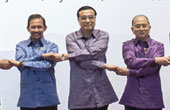Chinese market ripe for US pears
By Li Jing (China Daily USA) Updated: 2014-11-20 09:59
 |
|
Jennifer Clever, acting director of the US Embassy's agricultural trade office, and Louis Ng, China representative for the US pear industry, at a recent kick off campaign in Beijing to promote US pear sales in China. Photo by Li Jing / China Daily |
A new campaign in China to promote pears grown in the United States recently launched in Beijing, in what officials view as a favorable market across China for the imported fruit.
Pears from the US are new to the Chinese market. This is only the second year the fruit will be available in China, following an agreement between the US and China, pears from the US began to enter the Chinese market last year starting in January.
The campaign, which kicked off on Nov 15, had its first stop at a Sam's Club in Beijing. It will continue with about 30 road shows and promotional events in Shanghai and Beijing, from now until mid-January 2015.
Last season, which began in September 2013 and ended in April 2014, 460,000 boxes (10 kilograms per box) were imported to China, making it the sixth largest export market for US pears.
"I expected China to rank among the top three export markets for pears from the US within five seasons," said Louis Ng, China representative at Pear Bureau Northwest, a nonprofit marketing organization that promotes fresh Western-style pears grown in Washington and Oregon states, which combined produce 84 percent of the US' pear crop.
"The US pears have an unparalleled reputation for the highest food safety standards," said Ng. "With silky soft fiber and high nutrition value, our pears are very suitable for babies and toddlers." Pollution in China has regularly been cited as a major problem restricting the country's ability to grow quality food. Ma Yun, Alibaba Group Holding Ltd's founder and chairman, said farm products would be most viable in the Chinese market as the result, he was quoted by Benzinga.com. Last year, Alibaba sold 150 tons of Washington state cherries, 80 tons of nuts and a large amount of seafood from Alaska to consumers in China.
China is now the biggest global destination for US food and agricultural products and US farm exports to China nearly doubled from $13.1 billion in 2009 to $25.9 billion in 2013, according to the US Department of Agriculture.
To draw the young who are willing to pay premiums for higher-end products and often shop online, exporters and importers also seek to sell US pears online at Chinese e-commence giants such as Tmall and JD.com.
"The biggest challenge is the fact that US pear varieties are not well known to Chinese consumers or even many fruit importers and wholesalers," said Kevin Moffitt, president of Pear Bureau Northwest. "They are harvested when they are mature but not ripe. So consumers need to know how to select and ripen our pears to fully enjoy the sweet and juicy flavor."
The general lack of familiarity curb the popularity of the pears, which vary from firmer Asian varieties. Actually, Chinese pears, such as sand, Ya and fragrant varieties, face the same challenges in the US market.
Price is another challenge. The retail price of US pears at Sam's Club in Beijing, for example, is around 30 yuan a kilo. However China is the largest producer of pears worldwide so it has a good supply at cheaper prices. The retail price of US pears is around 6 to 10 yuan a kilo, based on reports from Chinese merchandisers.
"US pears have added costs and transportation making the price higher at retail. For these reasons most of the US pears are currently sold at the high-end supermarkets," Ng explained.
He added the price gap would narrow as the importing volume of the pears increase and prices of local farm products grow as the result of urbanization and increasing costs of migrant workers.
"Although China has opened its doors to all the US pear varieties, the red varieties - Starkrimson and Red Anjou - have been popular in China because of their auspicious color in local culture," Ng said. In addition, the Chinese name for "pears" reads like "fortune" in the Chinese language. These qualities make US pears a great fruit choice for Chinese consumers during festivals, he explained.
Lijing2009@chinadaily.com.cn










